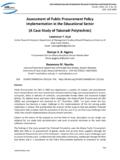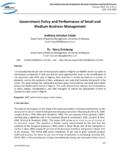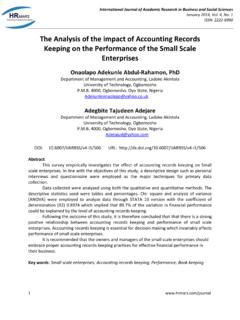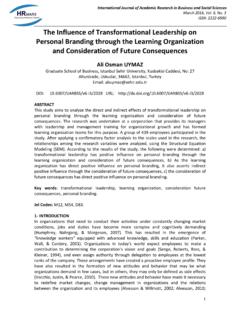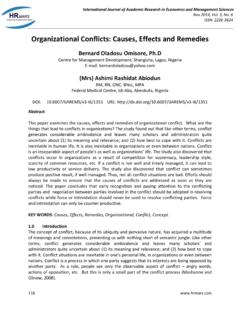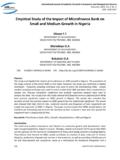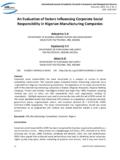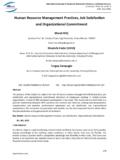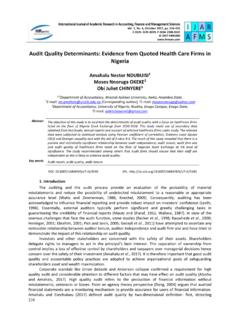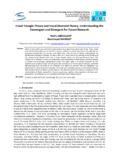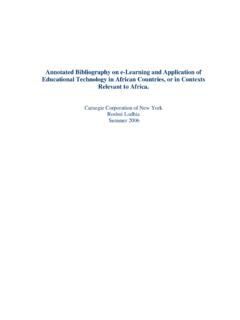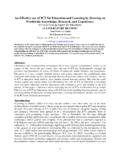Transcription of E-Learning and Its Effects on Teaching and Learning in a ...
1 International Journal of Academic Research in Business and Social Sciences January 2012, Vol. 2, No. 1 ISSN: 2222-6990 203 E-Learning and Its Effects on Teaching and Learning in a Global Age Olojo Oludare Jethro Computer Science Department, College of Education, Ikere, Ekiti State, Nigeria Adewumi Moradeke Grace Computer Science Department, College of Education, Ikere, Ekiti State, Nigeria Ajisola Kolawole Thomas Computer Science Department, College of Education, Ikere, Ekiti State, Nigeria Abstract E-Learning presents an entirely new Learning environment for students, thus requiring a different skill set to be successful (Romiszowski, 2004). Critical thinking, research, and evaluation skills are growing in importance as students have increasing volumes of information from a variety of sources to sort through (New Media Consortium, 2007).
2 Also, particularly in courses that are entirely electronic, students are much more independent than in the traditional setting. This requires that they be highly motivated and committed to Learning (Huynh et al., 2003), with less social interaction with peers or an instructor. Students in online courses tend to do as well as those in classrooms, but there is higher incidence of withdrawal or incomplete grades (Zhang, Zhou and Briggs, 2006). E- Learning can be viewed as computer assisted Learning , and as pedagogy for student-centered and collaborative Learning . Early developments in E-Learning focused on computer assisted Learning , where part or all of the Learning content is delivered digitally. More recently the pedagogical dimension of E-Learning has become prominent.
3 E-Learning comprises all forms of electronically supported Learning and Teaching . The information and communication systems, whether networked Learning or not, serve as specific media to implement the Learning process. Keywords: E-Learning , efficient, computer-based. Introduction E-Learning according to Markus(2008) can be defined as a Learning process created by interaction with digitally delivered content, network-based services and tutoring support E - Learning is any technologically mediated Learning using computers whether from a distance or in face to face classroom setting (computer assisted Learning ), it is a shift from traditional International Journal of Academic Research in Business and Social Sciences January 2012, Vol.
4 2, No. 1 ISSN: 2222-6990 204 education or training to ICT-based personalized, flexible, individual, self-organized, collaborative Learning based on a community of learners, teachers, facilitators, experts. E-Learning is the use of Internet technologies to enhance knowledge and performance. E-Learning technologies offer learners control over content, Learning sequence, pace of Learning , time, and often media, allowing them to tailor their experiences to meet their personal Learning objectives. to manage access to E-Learning materials, consensus on technical standardization, and methods for peer review of these resources. E-Learning presents numerous research opportunities for faculty, along with continuing challenges for documenting scholarship.
5 Innovations in E-Learning technologies point toward a revolution in education, allowing Learning to be individualized (adaptive Learning ), enhancing learners interactions with others (collaborative Learning ), and transforming the role of the teacher. The integration of E-Learning into education can catalyze the shift toward applying adult Learning theory, where educators will no longer serve mainly as the distributors of content, but will become more involved as facilitators of Learning and assessors of competency. E-Learning refers to the use of Internet technologies to deliver a broad array of solutions that enhance knowledge and performance. E-Learning can be used by medical educators to improve the efficiency and effectiveness of educational interventions in the face of the social, scientific, and pedagogical challenges noted above.
6 It has gained popularity in the past decade; however, its use is highly variable among medical schools and appears to be more common in basic science courses than in clinical clerkships. E-Learning is also called Web-based Learning , online Learning , distributed Learning , computer-assisted instruction, or Internet-based Learning . Historically, there have been two common E-Learning modes: distance Learning and computer assisted instruction. Distance Learning uses information technologies to deliver instruction to learners who are at remote locations from a central site. Computer assisted instruction (also called computer-based Learning and computer based training) uses computers to aid in the delivery of stand-alone multimedia packages for Learning and Teaching .
7 Multimedia Learning . Multimedia uses two or more media, such as text, graphics, animation, audio, or video, to produce engaging content that learners access via computer. Blended Learning , a fairly new term in education but a concept familiar to most educators, is an approach that combines E-Learning technology with traditional instructor-led training, where, for example, a lecture or demonstration is supplemented by an online tutorial. Faculty, administrators, and learners find that multimedia E-Learning enhances both Teaching and Learning . These advantages can be categorized as targeting either Learning delivery or Learning enhancement. Learning delivery is the most often cited advantage of E-Learning and includes increased accessibility to information, ease in updating content, personalized instruction, ease of distribution, standardization of content, and accountability.
8 Accessibility refers to the user s ability to find what is needed, when it is needed. Improved access to educational materials is crucial, as Learning is often an unplanned experience. Updating electronic content is easier than updating printed material: E-Learning technologies allow educators to revise their content simply and quickly. Learners have control over the content, Learning sequence, pace of Learning , time, and, often, media, which allows them to tailor their experience to meet personal Learning objectives. Internet technologies permit the widespread distribution of digital content to many users simultaneously anytime and anywhere. An additional strength of E-Learning is that it International Journal of Academic Research in Business and Social Sciences January 2012, Vol.
9 2, No. 1 ISSN: 2222-6990 205 standardizes course content and delivery; unlike, for instance, a lecture given to separate sections of the same course. Automated tracking and reporting of learners activities lessen faculty administrative burden. Moreover, E-Learning can be designed to include outcomes assessment to determine whether Learning has occurred. Advantages in Learning enhancement are a less well recognized but potentially more revolutionary aspect of E-Learning than are those related to Learning delivery. E-Learning technologies offer educators a new paradigm based on adult Learning theory, which states that adults learn by relating new Learning to past experiences, by linking Learning to specific needs, and by practically applying Learning , resulting in more effective and efficient Learning experiences.
10 Learning enhancement permits greater learner interactivity and promotes learners efficiency, motivation, cognitive effectiveness, and flexibility of Learning style. Learning is a deeply personal experience: we learn because we want to learn. By enabling learners to be more active participants, a well-designed E-Learning experience can motivate them to become more engaged with the content. Interactive Learning shifts the focus from a passive, teacher-centered model to one that is active and learner centered, offering a stronger Learning stimulus. Interactivity helps to maintain the learner s interest and provides a means for individual practice and reinforcement. Evidence suggests that E-Learning is more efficient because learners gain knowledge, skills, and attitudes faster than through traditional instructor-led methods.
